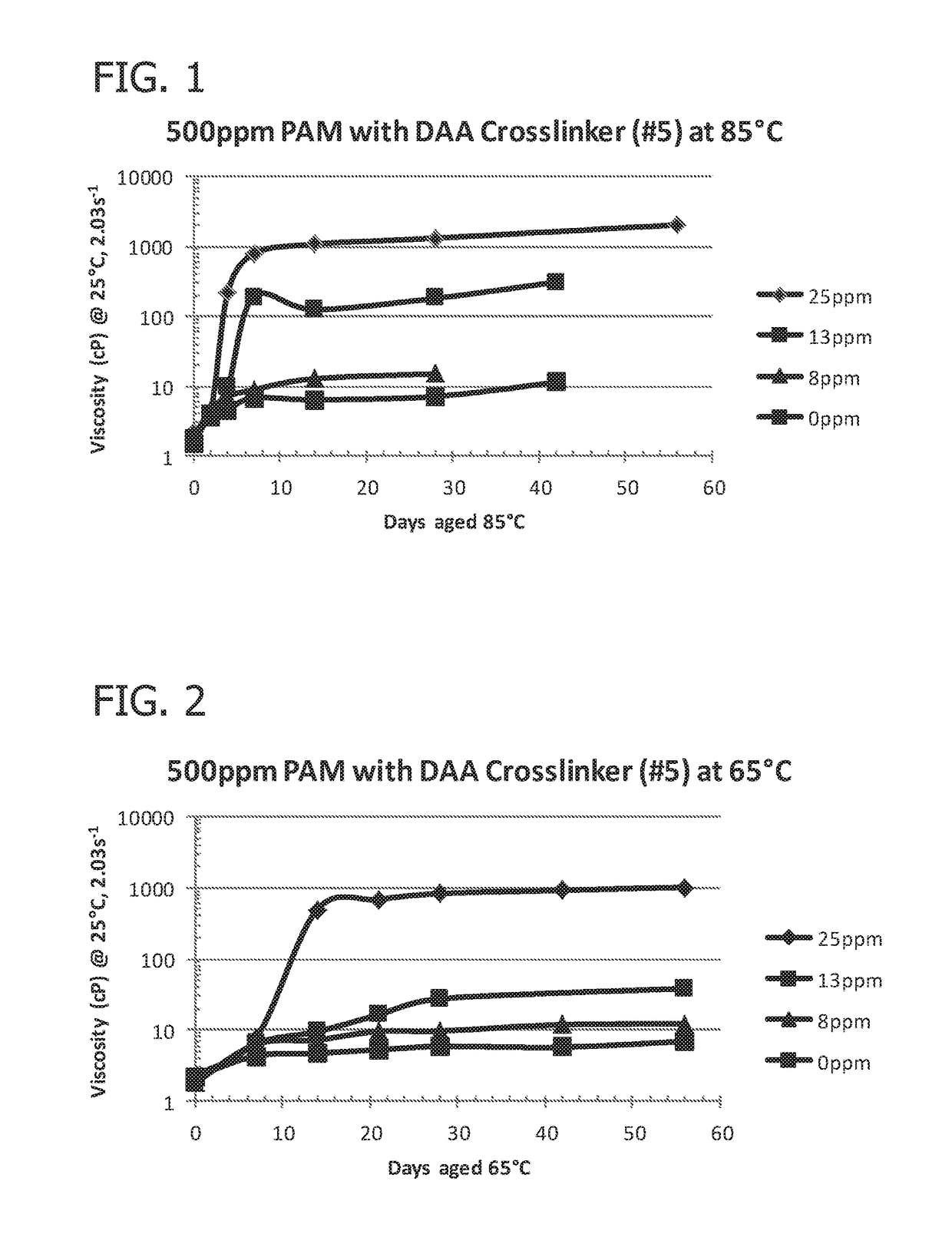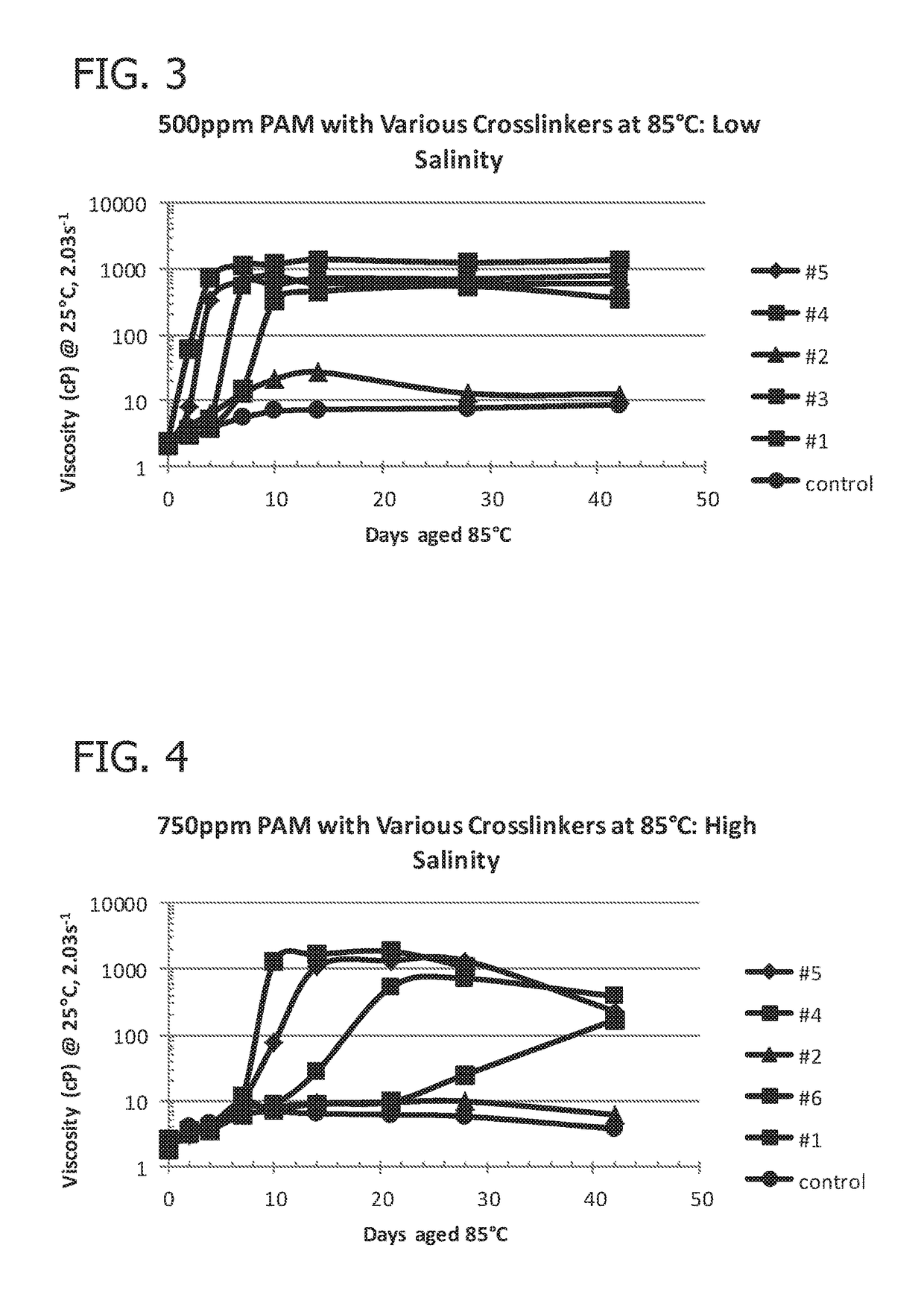Weak gel system for chemical enhanced oil recovery
- Summary
- Abstract
- Description
- Claims
- Application Information
AI Technical Summary
Benefits of technology
Problems solved by technology
Method used
Image
Examples
example 2
Preparation of Flowable Crosslinked Polymer
[0071]Crosslinker and potassium thiocyanate (KSCN; oxygen scavenger) stock solutions were prepared in brine immediately prior to gelant sample preparation. The appropriate amounts of polymer stock, brine, KSCN stock solution, and crosslinker stock solution were mixed together, in that order, to achieve the desired final flowable crosslinked polymer solution concentration. The flowable crosslinked polymer reactant samples were generally mixed by hand to achieve uniformity. After transferring to 20 mL headspace vials, the flowable crosslinked polymer reactant samples were sealed in a glove box under anaerobic conditions and then placed in ovens at the appropriate temperature for aging. After various aging times, new vials were removed from the oven each time and allowed to cool to ambient temperature before rheological testing.
[0072]Rheological testing was carried out using an Anton Paar MCR102 rheometer with a 25 mm plate-plate configuration...
example 3
Effect of Crosslinker Concentration on Gelation Time and Gel Viscosity at 85° C.
[0073]Table 2 presents data on the effect of the crosslinker / acrylamide polymer ratio on gelation rate and gel viscosity (the polymer being formed from the monomer ratios shown as #5 in Table 1). These samples were kept at 85° C. with a fixed polymer concentration of 500 ppm. As shown in Table 2 and FIG. 1, gel viscosity increases as crosslinker / polymer ratio increases. Therefore, by increasing the crosslinker / polymer ratio, a stronger gel was formed.
TABLE 2500 ppm PAM, DAA crosslinker (#5), 0.5% KCl,aged at 85° C.Viscosity @ 2.03 1 / sCrosslinker ppmDays @ 85° C.25 ppm13 ppm8 ppm0 ppm02.221.781.841.5224.094.034.423.6742199.627.074.6077781888.836.7614107512512.76.3828131118014.97.084230811.33562030
example 4
Effect of Crosslinker Concentration on Gelation Time and Gel Viscosity at 65° C.
[0074]Table 3 presents data on the effect of the crosslinker / acrylamide polymer ratio on gelation rate and gel viscosity for samples kept at 65° C. with a fixed polymer concentration of 500 ppm (the polymer being formed from the monomer ratios shown as #5 in Table 1). As compared to Table 2, the only variable changed was temperature. The same polymer, crosslinker, polymer concentration, and crosslinker / polymer ratios were tested. It can be seen from Table 3 and FIG. 2 that gelation time increases and gel strength decreases when the temperature at which the samples are aged is decreased from 85° C. to 65° C. Thus, the appropriate concentrations of acrylamide polymer and crosslinker can be chosen for a particular reservoir temperature.
TABLE 3500 ppm PAM, DAA crosslinker (#5), 0.5% KCl,aged at 65° C.Viscosity @ 2.03 1 / sCrosslinker ppmDays @ 65° C.25 ppm13 ppm8 ppm0 ppm02.2171.7821.8362.17677.6936.376.2444.3...
PUM
 Login to View More
Login to View More Abstract
Description
Claims
Application Information
 Login to View More
Login to View More - R&D Engineer
- R&D Manager
- IP Professional
- Industry Leading Data Capabilities
- Powerful AI technology
- Patent DNA Extraction
Browse by: Latest US Patents, China's latest patents, Technical Efficacy Thesaurus, Application Domain, Technology Topic, Popular Technical Reports.
© 2024 PatSnap. All rights reserved.Legal|Privacy policy|Modern Slavery Act Transparency Statement|Sitemap|About US| Contact US: help@patsnap.com










